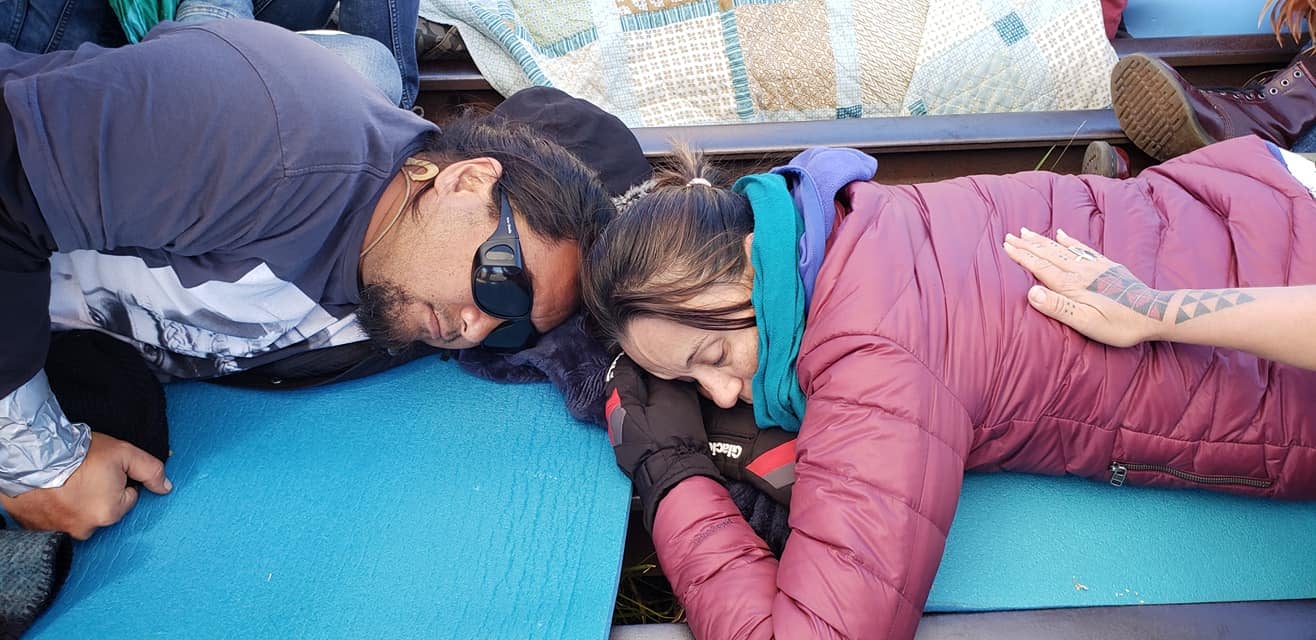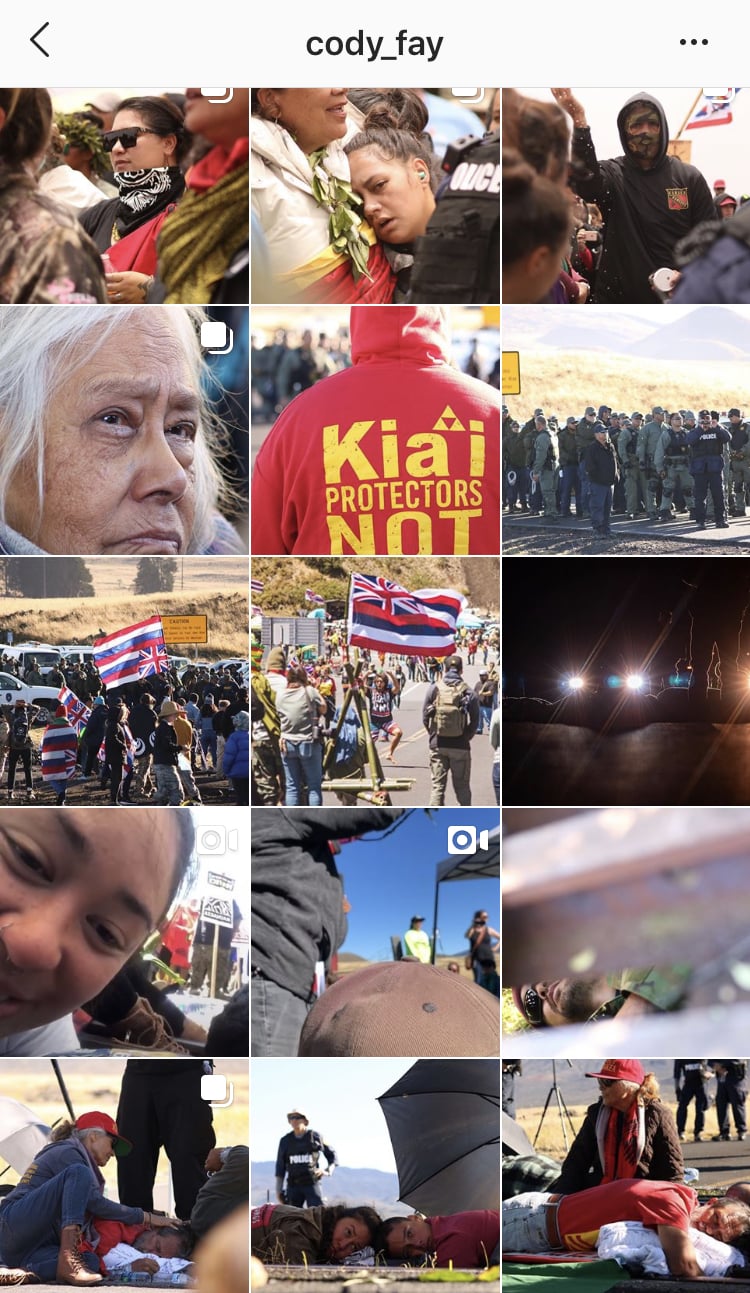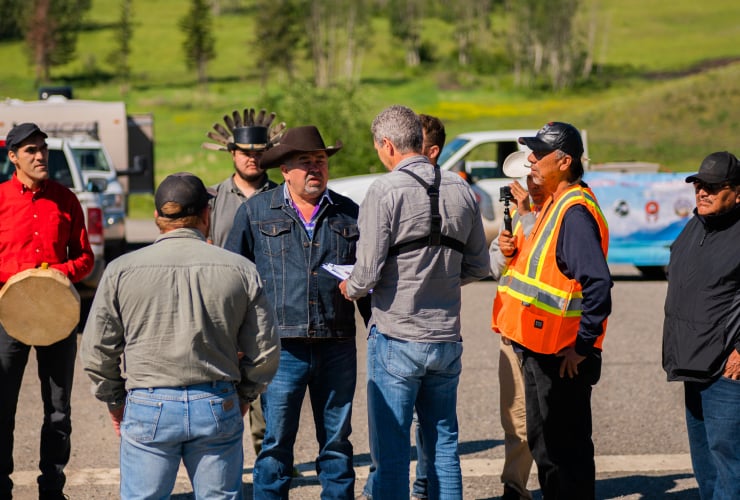Around three in the morning on July 15, Noelani Goodyear-Kaʻōpua, her partner and six other protectors chained themselves to the cattle guard at the Mauna Kea access road.
It was cold, dark and all eight people were willing to risk arrest for their actions.
What started as a small contingent of kia'i (guardians) standing together to protect their sacred Mauna Kea — a dormant volcano and, geographically speaking, the main watershed area for the island — from the development of a Thirty Meter Telescope (TMT) has escalated into a land protection movement beyond Hawai'i's islands.
The growing movement at Mauna Kea and across Hawai'i is the latest act of Kanaka Maoli (Native Hawaiian) self-determination and sovereignty. It’s a chapter in a long, rich history of Hawaiian independence and resistance to the settler state’s illegal overthrow of the kingdom 126 years ago.
Supporters of the US$1.4-billion TMT, such as the National Research Council of Canada (NRC), which provided funding of up to $243.5 million over 10 years, say the massive telescope will lead researchers deeper into space than ever before.
But the question continued to be raised is: at what cost?
The protectors spent over 11 hours on the cattle guard on the first day.
“While we were there, there was a gathering of hundreds of Kanaka and supporters at the base of the road," Goodyear-Kaʻōpua told National Observer after leadership between opposing camps found a temporary truce after a week of peaceful disruption. "The kupuna (elders) there had made a line and wanted to be a first line of defence."
Goodyear-Kaʻōpua was one of the first to stand arm-in-arm with other wahine (women) to protect elders from heavily armed officers. She’s Kanaka Maoli and an associate professor at the University of Hawaiʻi at Mānoa. She also a fierce protector of her mauna (mountain) and ‘āina (land).
Goodyear-Kaʻōpua shared three reasons behind why she thinks construction of the TMT is unfathomable. She also shared tense moments from the front lines of the protest and criticized the ethical standards of research for the project.
1. 'It's the home of our deities'
Mauna Kea is a sacred place for Goodyear-Kaʻōpua.
“In various water forms, the mists, the rains, the clouds that envelop the mountains creates water that percolates down through volcanic rock and charges the groundwater supply,” Goodyear-Kaʻōpua said. “Living on islands in the middle of the ocean, it’s where we get our fresh water, a source of life.
“It’s also the home of our deities who are embodied in the various water forms.”
For centuries Kanaka families have buried the bones of their ancestors at Mauna Kea, as well as chords of newborn babies, symbolizing their sacred connection to their ancestors, Goodyear-Kaʻōpua said.
What makes something sacred?
— Jamaica Osorio (@jamaicaosorio) July 11, 2019
Is Mauna Kea sacred because she is the highest point in nā kai ‘ewalu and the broader pacific?
‘Ae.
Is Mauna Kea sacred because of its connection to the genealogy of our people and our Akua Wākea?
‘Ae.
2. Hawaiian national lands
Mauna Kea is a part of the body of lands seized from the Hawaiian Kingdom 126 years ago. The land taken, after the United States overthrew the Hawaiian monarchy, was eventually returned in 1959 when Hawaiʻi was admitted as a state. In 1993, the U.S. Congress adopted a joint resolution, apologizing for the annexation of the Hawaiian archipelago.
“Weak as it was, Congress’ apology in 1993 acknowledged that we never relinquished the land," Goodyear-Kaʻōpua said. "It’s unceded, unrelinquished lands of our country.”
OHA LEADERSHIP DEMANDS HALT TO TMT CONSTRUCTION TO AVOID HARM TO NATIVE HAWAIIANS AND THE PUBLIC UNTIL STEPS ARE TAKEN TO ENSURE PUBLIC SAFETYhttps://t.co/DhfxC1xHjT#Maunakea #Aina pic.twitter.com/P7rtPcOqnt
— OHA (@oha_hawaii) July 14, 2019
3. Conservation lands
Goodyear-Kaʻōpua stressed, even within a settler state, the lands at Mauna Kea are zoned for conservation, as all important watershed lands are.
The conservation district in the State of Hawaiʻi is mandated to protect and preserve natural resources necessary for the survival of the people, though there are conditions under which a company can get access to a permit and build on protected lands.
“Although the state is arguing that it has met those conditions, you know, protectors of the mauna contest, whether the project actually is appropriate,” Goodyear-Kaʻōpua said, adding the 18-storey, acres-wide building would leave a large, "totally inappropriate" footprint on the island.
The Conservation District Use Permit needed to build the massive telescope has been contested in all levels of courts since 2010. On Oct. 30, 2018, the Hawai'i Supreme Court, by majority decision, issued its affirmation to the Board of Land and Natural Resources’ decision to issue the permit for construction at Mauna Kea. On June 19, the Hawaiʻi Department of Land and Natural Resources issued a notice to proceed (NTP) to the University of Hawaiʻi for TMT.
When Kanaka Maoli community members heard of the notice, they prepared for a long battle, Goodyear-Kaʻōpua said.
‘It’s our kuleana (responsibility)’

Imai Winchester and Noelani Goodyear-Kaʻōpua chained themselves to the cattle guard at the main access road at Mauna Kea for eleven hours, blocking heavy machinery on July 15, 2019. Photo provided by Goodyear-Kaʻōpua
There are now thousands of people at Mauna Kea, and seasoned organizers have developed systems to manage food, supplies, medical care and information. The base camp has transformed into a community-based place of learning, with language workshops, dancing, singing and storytelling taking place daily.
Goodyear-Kaʻōpua’s partner, Imaikalani Winchester, has been by her side from the start.
“It’s our kuleana (responsibility). It’s our burden as well as our privilege to show our children, and the rest of the world, how much we love our land,” Winchester told KHON2 news reporter in an interview July 15.
Winchester is a teacher at Hālau Kū Māna Public Charter School in Honolulu and is one of the kia’i (protectors) who were informed that they were under arrest by city police, Goodyear-Kaʻōpua recounted.
As the hours stretched out for the protest, the engine of the law enforcement officers’ vehicle died and they retired for the day, withdrawing any threats of arrest. Goodyear-Kaʻōpua said her people took this as a sign.
In the following sound clip, Goodyear-Kaʻōpua explains the events that unfolded for the kia'i and kupuna from the base camp of Mauna Kea.
After 36 kupuna were arrested, and Goodyear-Kaʻōpua heard that the police were expected to dig in their heels. In an effort to protect the remaining elders, a group of around a hundred wahine stood together, linked arms, and created a line of protection. The kane (men) supported the wahine, standing in front of the elders and showing police forces the strength of their lāhui (people).
As July 19 wore on, Hawaiian Governor David Ige declared a state of emergency. With his act, Hawai'i drew all power of command to all county police forces as well as the National Guard.
On Wednesday, July 17th, a heavily armed police force arrested over 20 Native Hawaiian elders who were peacefully protecting Mauna Kea from desecration. #TMTShutdown #AoleTMT #KuKiaʻiMauna pic.twitter.com/igh2SFtjkm
— Victims of Capitalism Memorial Foundation (@karaokecomputer) July 18, 2019
“That really put everyone in the camp on high alert and tension has been really high since then,” Goodyear-Kaʻōpua said. “Any research project that requires massive police force and the National Guard to be called, and hundreds and hundreds of people protesting flies in the face of any ethical standards of research that I can see.”
The TMT would be three times as wide, with nine times more area than the largest existing visible-light telescope in the world. It would enable sharper and deeper images than telescopes on the ground and in space. Supporters of the project say its capacity could revolutionize our understanding of the universe, according to the National Research Council of Canada.

Canada’s participation
In 2015, the Canadian federal government announced up to $243.5 million over 10 years to support Canada’s participation in the TMT construction. The total construction cost is estimated to be US$1.4 billion.
The Association of Canadian Universities for Research in Astronomy (ACURA) acts as Canada’s scientific authority for the TMT project. ACURA is an organization of Canadian universities dedicated to the advancement of research and teaching in astronomy and astrophysics.
A representative from ACURA, Don Brooks, was not available for comment.
When asked why the National Research Council of Canada supports TMT, a spokesperson said access to the world-class, state-of-the-art facility will “allow Canadian researchers and students to continue to collaborate with international teams to advance the scientific understanding of the universe.”
“The TMT will provide the opportunity for economic and educational advancement in Hawaii, particularly for future generations,” the spokesperson wrote in an email. “Great care has been taken to identify the best location for the TMT, to have minimum impact out of respect for Mauna Kea’s rich ancestral history and the spiritual beliefs of native culture.”
As an associate social sciences professor at the University of Hawaiʻi, Goodyear-Kaʻōpua said she's well aware of protocols around research that involves humans, but she said she’s curious as to how researchers defend TMT when it has such devastating social impacts.
“Their research infrastructure impacts human societies, particularly vulnerable populations, particularly Indigenous people,” Goodyear-Kaʻōpua said. “How do they rationalize that cost?”
When asked whether the TMT would strengthen humans’ understanding of how to best address human rights issues, the NRC representative spoke to the technological capabilities.
“The TMT will observe the formation and development of the large-scale structures by looking at faint distant galaxies and the intergalactic medium, providing information on the physics of the early universe and the nature of dark matter that are inaccessible using any other techniques,” NRC wrote.
TMT’s high resolution will extend scientist’s capability to investigate black holes, including the black hole in our Milky Way, he wrote, advancing our knowledge of star and planet formation.
#LATEST: @HawaiiNewsNow has confirmed @GovHawaii Ige has left Hawai’i Island without a visit to #Maunakea to assess the situation he declared an emergency last week. Thousands are expected to join the #TMT protest today against the #ThirtyMeterTelescope https://t.co/Ulgr5eWvar pic.twitter.com/a2KMeiaOEs
— Mileka Lincoln (@MilekaLincoln) July 20, 2019
A representative for the TMT project, Scott Ishikawa said the company respects everyone’s rights to express their opinions, but that the issue is “not about TMT or science.”
“Among those who remain opposed are many who see TMT as an icon for what they believe is the wrong side in the much larger political issue of Hawaiian sovereignty,” Ishikawa wrote. “Whether or not TMT is built will not bring closure. We remain hopeful that we can find a way forward, in mutual respect.”
Ishikawa said their company, early in the process and over the last ten years, has worked with community members, to ensure the site selected was not in or around areas considered sacred, and that they embraced the best practices in environmentalism.
TMT developed programs that provide such community benefits as the $1 million per year THINK Fund to support STEM education for Hawaii Island youth and the $1 million per year Workforce Pipeline to create better-paying jobs for Hawaii Island residents.
But Goodyear-Kaʻōpua said she doesn’t think TMT supports communities. Least of all, hers. She said she defends the mauna for her children and that she has publicly called partners in the project to withdraw their support and for people to divest from the companies that have failed to do so.
Goodyear-Kaʻōpua’s two youngest children stayed home while their parents fought for their futures. But her eldest daughter, 19-year-old Hina Kaʻōpua Canonigo, stood by her side. Goodyear-Kaʻōpua said many people don’t realize who these so-called “protestors” really are.
“We are teachers that educate your children. We are nurses and doctors that care for your sick families. We are counselors and psychologists that help our people deal with emotional trauma. We are healers of all kinds. We're accountants and computer technicians. We're farmers,” Goodyear-Kaʻōpua said. “There are young kids there, high school students, college students, undergraduates and graduate students.”
Families have been divided by this issue, too, she said.
“There are siblings and cousins of law enforcement officers. Some families on one side and the other,” she said, adding there has been an outpour of support from Native Hawaiian attorneys and medics, providing services to people on the mountain.
Which explains Goodyear-Kaʻōpua words to law enforcement when they were face-to-face.
“Brother, before you use your weapons on us, before you spray us, before you arrest us, know who we are," she said.
Not the usual story where
Not the usual story where some proposed industrial development is going to turn a natural habitat into a ruined hellscape.
Actually, this wasn't all I needed to know. The story kind of failed on a few journalistic minima: how much land will the TMT take up? How big is the top of Mauna Kea? It would have been helpful to readers to know there are already 14 telescopes up there and this is the 15th. (Does that make this worse, or better?)
On google maps, it's clear that the tippy-top of the very gentle slopes of MK is a dozen kilometres across, with about a 3km x 4km area devoted to the telescopes and the access roads between them. (Wikipedia says nearly 5000 cars use the access road per month, with tourists coming to see the view being nearly 4000 of them, the observatory staff the other 1000. 300,000 people hit the Mauna Kea visitors centre at the bottom every year. Is the TMT the big problem, here?
And also, are the Hawaiian people united in this concern, or are there a lot of their number who think that this is appropriate because nothing could be more sacred than exploring the universe?
I am not Hawaiian and have
I am not Hawaiian and have never been to Hawaii, but some of my ancestors were there and were supporters of the native Hawaiian government, so I feel on their side. Madam Pele has been doing some upkeep on her island. I wonder if she would act if this is bad enough?
Maybe the Canadian government
Maybe the Canadian government would like to offer up Parliament Hill for the project.
Or the US government could provide Arlington Cemetery. Neither of them are a watershed area, either.






Comments